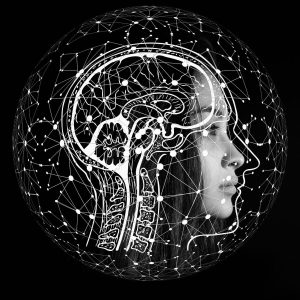Cognitive psychology explores how we think, perceive, and process information. From attention and memory to decision-making, this field bridges neuroscience and psychology. Learn about its origins, key theories, and how modern research, including eye tracking and EEG, advances our understanding of cognition.
Table of Contents
Cognitive Psychology is the science of how we think. It’s concerned with our inner mental processes such as attention, perception, memory, action planning, and language. Each of these components are pivotal in forming who we are and how we behave.
The thoughts related to these concepts can be conscious or nonconscious – we might consciously make an effort to focus our attention on a lecture for example, but the light flickering in the room could trigger a nonconscious shift elsewhere.
Many cognitive psychologists [1] refer to this field as encompassing both the traditional cognitive psychology approach and also cognitive neuroscience. Cognitive neuroscience is a field that uses neuroimaging methods to examine cognitive processes – it has many overlaps with cognitive psychology, and takes a similar approach and worldview, but offers a route to visualize the brain activity that is associated with these inner thoughts.
Cognitive psychology also has many overlaps with cognitive neuropsychology (primarily concerned with the effects of brain damage on cognition) and to an extent, with computational neuroscience (concerned with creating computational models of brain function).
The beginnings of cognitive psychology
To really understand the basis for these overlaps, it’s important to consider the context and time in which cognitive psychology emerged. Starting as a disciple in the 1950’s, the field was in some sense a reaction to the dominant psychology research approach at the time – behavioral psychology (a topic we’ve covered before in a previous blog post).
Behavioral psychology starts with the precept that all human behavior is learned and adaptable to the context and environment it’s in. Behavior can be reinforced or punished in various ways, leading to increases or decreases of certain actions. As life progresses, a set of behaviors is ultimately shaped by these experiences giving rise to a multifaceted human with varying interests, desires, pursuits, skills, and habits.
Cognitive psychology on the other hand essentially assumes more agency – thoughts and feelings are seen as more active in the process of behavior formation. Individuals are perceived to process thoughts that determine if and how behaviors are to be carried out (rather than being seen as a more passive recipient and producer of experiences or behavior).
This paradigm shift, from a primarily behaviorist view to a primarily cognitivist view, has multiple triggers and it is difficult to single out a single source. However, some crucial influences can be found in the emergence and development of information theory (a formalization of information communication that has similarities with the cognitive approach) [2], and Noam Chomsky’s devastating critique of behaviorism.
Information theory, computers, and cognition
Information theory was – and remains – important as it formalizes how information communication occurs. The extent of influence and reach of this theory is difficult to overstate – almost any domain that features the transmission of information (be it signaling in the brain, genetics, physics, and beyond) has been influenced by information theory in some way.

Information theory emerged hand-in-hand with the most important invention of modern times – that of the computer. The emergence of the computer invited parallels (both in the popular and scientific imagination) to the way in which the brain processes the world – a logical breakdown of inputs, outputs, storage, and processing were easily compared with stimuli / the environment, behavior, memory, and cognition, respectively.
This helped give rise to cognitive psychology by considering the brain as a computational device, the rules of which could be formalized, reduced, and understood. While behaviorism also followed a reductionist approach, it largely avoided (or downplayed the importance of) the process and impact of inner thoughts.
Chomsky vs. Skinner
One of the other pivotal influences that lead to the (temporary) dampening of behaviorism, and the emergence of cognitive psychology, emerged from an intellectual debate about linguistics.
B.F. Skinner, the central figurehead of behaviorist psychology, posited in an article that language is learned in a behaviorist manner – words are memorized, spoken, and understood purely because the sound, production, and meaning is reinforced. Noam Chomsky wrote a critique to Skinner’s article on language, stating that an innate component must exist to drive language development, as language is essentially too regular and learnt too quickly to be explained solely by reinforcement.
The disagreement essentially echoed that of “Nature vs. Nurture” – with Skinner arguing for nurture, and Chomsky for nature. In reality, both persons involved had and developed more nuanced views of linguistics and learning. Ultimately, neither of them was ever completely correct, yet the critique led to many psychologists reconsidering the dogma of behaviorism – and the new framing of the cognitive approach was brought forward as a result.
Current Cognitive Psychology
As the approach of cognitive psychology became more accepted and popular, several influential studies have emerged that show the utility of this approach.
In the 1950’s and 1960’s, Alfred Yarbus, a Russian psychologist, showed how saccadic eye movements could reflect inner cognitive processes [3]. This was a breakthrough not in the sense that eye movements were related to cognition, as this was widely anticipated, yet in sheer scope and ingenuity. Yarbus’ device was attached – by suction – to the eyeball, providing a new level of accuracy that provided reliable answers to a plethora of questions concerned with the minutiae of eye movements and cognitive processes.
Recent studies have built upon this work with eye tracking glasses, showing how an investigation of cognitive processes can be expanded to naturalistic environments [4]. Research has revealed not only how detailed eye movements change in relation to stimuli, but also how the previous debate between cognitive and behavioral psychology is moot. Eye movements are shown to be dependent on cognitive processes, that in turn are guided by behavioristic principles [5, 6, 7]. Cognitive processes rule by the invisible hand of reinforcement.
The development of ideas surrounding cognition have also impacted how reactions to facial expressions are understood. Researchers from Uppsala University in Sweden investigated the nonconscious muscle movements of the face that occur in response to subliminal exposure of emotional facial expressions [8].
By using a masking technique (to prevent conscious evaluation of the presented faces), and facial electromyography (to detect changes in muscle activity that may not be visually detectable), the researchers were able to show how psychophysiological responses occur in even in the absence of conscious awareness, suggested to be the result of nonconscious cognitive processes [9].
Another understanding of the brain influenced by the emergence of cognitive psychology is that of cognitive load. A term coined by John Sweller from New South Wales University in 1988, it refers to the amount of working memory required to complete the task at hand. Similar to RAM in a computer, researchers have attempted to define the processes that are occurring in the brain when cognitive load is high.
A study by researchers from the University of California in 1994 examined brain activity using EEG with 14 Air Force pilots in an aircraft simulator [10]. It was found that alpha wave activity (within 7-12 Hz) was suppressed (i.e. activity within this range occurred less) as task difficulty, and thus cognitive load, increased.

A further study carried out by scientists at the San Francisco Brain Research Institute [11] echoed these results, finding a general suppression of alpha activity, yet also an increase of theta activity (4-7 Hz) in concordance with task difficulty. While the results can vary, cognitive load appears to generally associate with desynchronization of alpha wave activity, and a synchronization of theta wave activity.
Interested in Human Behavior and Psychology?
Sign up to our newsletter to get the latest articles and research send to you

Conclusion
These studies represent of course a mere fraction of scientific literature that has been impacted by the emergence of cognitive psychology; many more influential studies have been created and executed under the framework of cognitive psychology.
The preeminence of cognitive psychology was not to last forever, it remains a central topic in modern psychology research. It is often tempting to view humans in siloed terms (e.g. people operate solely on behaviourist / cognitivist / other terms), yet there is likely a great deal of overlap, and no real “winner”. The progress of each theory builds collectively better ideas that inch us towards a more objective and accurate understanding of human psychology.
While scientific thinking and theories have now expanded further beyond the rigid dichotomous dogma of cognitive / behaviorist schools of thought, the new findings that were revealed along the way remain immensely valuable when considering the function of the mind, brain, and behavior. A more holistic, and yet nuanced, view is shown by modern scientific research that benefits from the past fixations of previous theories.
To read more about how psychological theories build modern ideas about human behavior, and how human behavior is studied today, download our free guide below.
Free 52-page Human Behavior Guide
For Beginners and Intermediates
- Get accessible and comprehensive walkthrough
- Valuable human behavior research insight
- Learn how to take your research to the next level

References
[1] Eysenck, M., & Keane, M. (2005). Cognitive psychology. Hove: Psychology Press.
[2] Anderson, J.R. (2010). Cognitive Psychology and Its Implications. New York, NY: Worth Publishers.
[3] Yarbus, A. (1967). Eye Movements and Vision. Plenum Press
[4] Hayhoe, M., & Ballard, D. (2005). Eye movements in natural behavior. Trends In Cognitive Sciences, 9(4), 188-194. doi: 10.1016/j.tics.2005.02.009
[5] Glimcher, P. (2003) The neurobiology of visual-saccadic decision making. Annu. Rev. Neurosci. 26, 133–179
[6] Hikosaka, O. et al. (2000) Role of the basal ganglia in the control of purposive saccadic eye movements. Physiol. Rev. 80, 953–978
[7] Stuphorn, V. et al. (2000) Performance monitoring by the supplementary eye field. Nature, 408, 857–860
[8] Dimberg, U., Thunberg, M., & Elmehed, K. (2000). Unconscious Facial Reactions to Emotional Facial Expressions. Psychological Science, 11(1), 86-89. doi: 10.1111/1467-9280.00221
[9] Kihlstrom, J.F. (1987). The cognitive unconscious. Science, 237, 1445–1452.
[10] Sterman, M. B., Mann, C. A., Kaiser, D. A., & Suyenobu, B. Y. (1994). Multiband topographic EEG analysis of a simulated visuomotor aviation task. International Journal of Psychophysiology, 16, 49–56.
[11] Gevins, A., & Smith, M. E. (2000). Neurophysiological measures of working memory and individual differences in cognitive ability and cognitive style. Cerebral Cortex, 10, 829–839.












